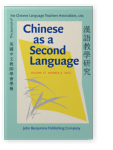Vol. 57:2 (2022) ► pp.119–140
Applying the performed culture approach in collegiate beginning and intermediate level Chinese courses
The case of Integrated Chinese
This paper discusses how to use the Performed Culture Approach (PCA) to design collegiate Chinese beginning and intermediate level courses. As a pedagogical framework to improve learners’ intercultural communication skills, PCA has gained increasing recognition by scholars in the field. However, many instructors still face the challenge of deciding how to apply PCA in different Chinese language programs and with non-PCA informed pedagogical materials. Through a three-year implementation at an American university which adopts Integrated Chinese (IC), one of the most popular pedagogical materials in American college beginning- and intermediate-level Chinese courses, the article analyzes IC’s instructional challenges, PCA-based curriculum design, learning outcomes, and student feedback. The article finally discusses general principles of applying PCA in different programs with various pedagogical materials.
Article outline
- Performed culture approach (PCA)
- Integrated Chinese (IC)
- Curriculum design
- Designing course structure
- Creating supplementary oral practices
- Eliciting authentic spoken performances in the target culture
- Building reading and compositional cultural performances
- Making adjustments for online classes
- Learning outcomes and student feedback
- Conclusion
- Acknowledgements
- Notes
-
References
